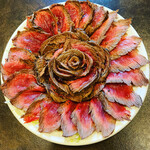
がぶ
Gabu
3.34
Fudomae, Musashi-Koyama, Nishikoyama
「Western Cuisine」
2,000-2,999円
1,000-1,999円
Opening hours: (Mon-Sat) 11:30~13:30Lo. 18:00~20:30Lo (Tue) 11:30~13:30Lo Lunch only (Sun & Holidays) 11:30~13:30Lo. 18:00~20:00Lo Open Sunday
Rest time: Wednesday
東京都品川区小山3-2-3
Photos
(20)

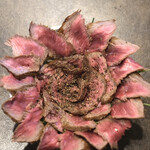
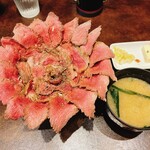
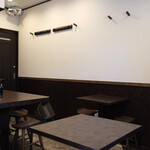


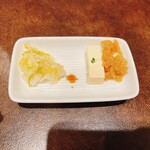
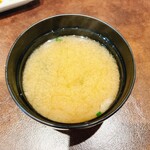
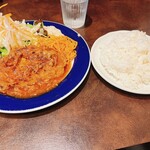
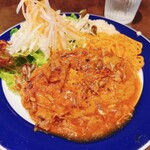
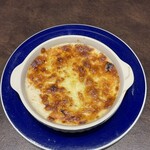
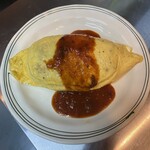


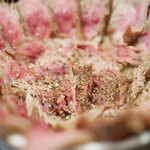

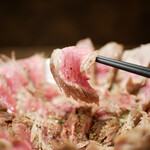
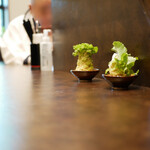
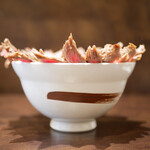
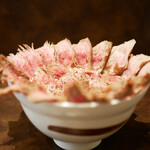
Details
Reservation Info
can be reserved
Payment Method
No credit cards
Electronic money is not accepted
QR code payment is not available
Number of Seats
13 seats
Private Dining Rooms
None
Smoking and Non-Smoking
No smoking at the table
Parking
None
Parking available nearby
Drink
Sake available, shochu available, wine available
Comments
(21)
いなやまん
4.40
I went to Gabu in Shinagawa, Tokyo in February. Originally, I was supposed to go to Okinawa, but for some reason, I ended up in Tokyo. So, I decided to finish my errands in the morning and enjoy Tokyo's food in the afternoon. For lunch on the first day, I went to Gabu in Musashi-Koyama for their famous roast beef bowl. The restaurant is located about a 3-minute walk from Musashi-Koyama Station on the Tokyu Meguro Line. The interior is chic with brown tones, and there are about 13 seats at the counter and tables. I decided to order the Gabu bowl, which comes in three sizes based on the amount of roast beef: 180g for 1600 yen, 270g for 2300 yen, and 453g for 3850 yen. Since it was my first visit, I ordered the 1.5 times size. After about 15 minutes, the 1.5 times Gabu bowl arrived, and it looked impressive with a generous amount of thinly sliced roast beef. The roast beef was crispy on the outside and beautifully rare on the inside, allowing me to fully enjoy the umami flavor of the lean meat. The original sweet soy sauce-based sauce and freshly ground black pepper added to the deliciousness of the roast beef. I also enjoyed the miso soup, pickles, and tsukudani served on the side. I finished every last bit and was completely satisfied. Next time, I have already decided to order the 1-pound size. I am looking forward to it. Thank you for the delicious meal.
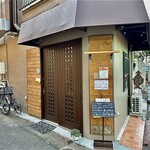
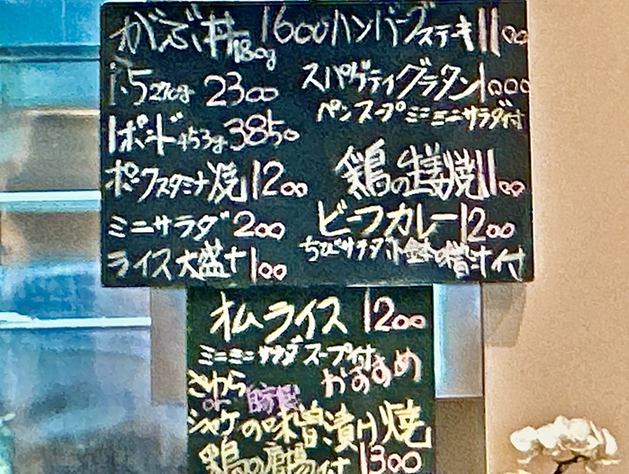
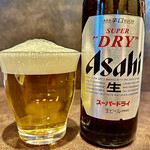
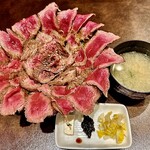
ちゃいくん16
5.00
Weekly delight, dinner with my girlfriend at Gabu♪ My top recommendation is the baked curry! It's not on the menu, but it's written on the wall so I highly recommend trying it at least once. It's curry rice topped with tender beef tendons and cheese, a truly amazing dish! Let's come back next week to have it again! ( ^ω^ )

seiko619
3.70
This weekend's lunch was Western-style. After seeing the "Roast Beef Don" introduced on a TV show (Arashi ni Shiyagare) in 2019, I had been wanting to visit "Gabu" for a while. Finally, I made my first visit after going through the COVID-19 pandemic. The restaurant seemed to have moved during this time, but it was easy to find by walking along the alley on the high school ground side from the west exit of Musashi-Koyama Station. Of course, I ordered their specialty dish. I had the Gabu Don (180g) for ¥1,600, and my companion had the Hamburger Steak for ¥1,100. The beautifully arranged roast beef looked like a flower, with probably more than 20 slices. Under the roast beef, there was shredded cabbage, then rice, topped with sauce and black pepper. The black pepper complemented the dish well. The amount of rice was just right for me, but there are two larger sizes available on top of this. My companion seemed to be very satisfied with the cost-effective and delicious hamburger steak. It was a delicious meal. Thank you for the feast.

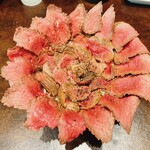
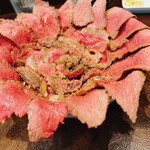

中目のやっこさん
4.00
Located near Musashi-Koyama Station, the Western-style restaurant "Gabu" is known for its famous roast beef bowl. I visited for lunch to try this dish. The restaurant is about a 1-minute walk from the west exit of Musashi-Koyama Station. The small, inconspicuous storefront with a handwritten menu board. I arrived during the weekday opening hours and was able to enter without waiting. Inside, there is a cozy atmosphere with a counter seating for 4, 4 two-person tables, and the place is run by the owner and his mother. The specialty dish is the "Gabu Bowl," which comes in three sizes: 180g for 1,600 yen, 270g for 2,300 yen, and 453g for 3,850 yen. They also offer other Western-style lunch menu items. I ordered the following:
- Gabu Bowl 180g for 1,600 yen
The sound of sizzling stir-fry from the kitchen was louder than the Southern music playing softly in the background. The dish arrived in about 15 minutes. The excitement grew as the dish was served from above the counter! The bowl was filled with spiral-shaped, petal-like slices of roast beef, arranged in a gradient of pink rareness, overflowing the edges of the bowl. The pepper sprinkled in the center released a pleasant spicy aroma. I took a bite of the roast beef, enjoying the tender texture and rich flavor, complemented by the peppery kick. The shredded cabbage on top of the rice added a crunchy texture, and the sweet sauce soaked into the rice, creating a smooth eating experience. Despite its thick appearance, the dish was surprisingly easy to finish. It was a unique experience to savor each slice of roast beef. The restaurant quickly filled up around noon, so it's best to visit right after opening if you want to secure a seat. The roast beef bowl is a must-try for its dazzling presentation and delicious taste. Regular customers were also enjoying dishes like the Pork Stamina Yaki, which seemed equally appetizing. Make sure to capture the Instagram-worthy sparkle of this specialty dish when it's served. Enjoy the Gabu Bowl at this gem near Musashi-Koyama Station.
Gabu
Address: 3-2-3 Koyama, Shinagawa-ku, Tokyo
Phone: 03-5722-1766
Business Hours: 11:30-13:30, 18:00-20:30
Closed on Tuesdays (Dinner) and Wednesdays
Stay Time: 30 minutes
Total: 1,600 yen (cash only)
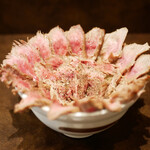

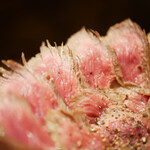

ちゃいくん16
5.00
Today, I went to my favorite restaurant Gabu. I usually order the baked curry doria, but today I tried the beef tendon in demi-glace sauce for the first time. It was amazing! The beef tendon was so tender and delicious. The other photo is of the cheese hamburger that my girlfriend always orders. Everything here is delicious. I can't wait to come back next week!
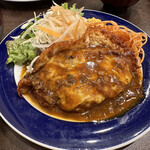
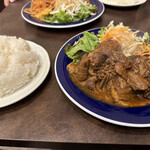
ishiyama1480
3.70
"Ishii's Solitary Gourmet" I like the relaxed feeling of "Moya-sama" and I wanted to go to "Kuishinbo Ga Bu" in Musashi-Koyama. By the way, there was an owl outside on TV, but it wasn't there that day (laughs). I ordered the signature dish, the Gabu Don (1,600 yen). Doesn't the 180g roast beef look amazing? The slightly sweet seasoning with a hint of black pepper is irresistible. The roughly chopped cabbage underneath adds a nice touch. Despite the generous portion, it's not tiring at all. It's truly satisfying. This could become quite addictive. The funky owners are also very friendly, and it seems like a place with many regular customers.
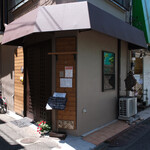
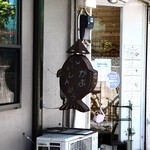
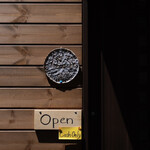

美食家 K
3.20
"Gabu" is a famous restaurant in Musashi-Koyama known for its meat bowls. The signature menu item, Gabu Don Standard 180g for 1600 yen, is often featured in the media. The bowl is filled with thinly sliced roast beef, making it perfect for social media posts. Underneath the roast beef, there is cabbage, and the combination of peppery roast beef, sweet and savory sauce, and flavorful rice is delicious. The original sweet soy-based sauce and black pepper provide a nice accent. It's tasty, but for 1600 yen, the cost performance may not be the best. The restaurant's name is Gabu, and it is located just a 3-minute walk from Musashi-Koyama Station West Exit. The opening hours are Monday to Saturday from 11:30 to 13:30 (last order) and from 18:00 to 20:30 (last order), and on Tuesdays only for lunch from 11:30 to 13:30 (last order). It is open on Sundays and public holidays from 11:30 to 13:30 (last order) and from 18:00 to 20:00 (last order). The restaurant is closed on Wednesdays. Reservations are accepted, and the budget ranges from 2000 to 2999 yen for dinner and from 1000 to 1999 yen for lunch. Other information includes no private rooms, no full restaurant reservations, all seats are non-smoking, and there is no parking available (but there are parking lots nearby). #Gabu #MusashiKoyamaGourmet #MusashiKoyamaLunch #MeatBowl #TokyoDonburi #Yakiniku #GourmetLovers #GourmetInstagram #GourmetMemo #GourmetLoversWanted #FoodPornGram #FoodTerror #GourmetTravel #DeliciousIsHappiness #GourmetFriendsWanted #FoodieClub #FoodieGirls #FoodieBoys #WantToConnectWithGourmets #KantoGourmet #FoodReviewGram #GourmetReporter #FoodWriter #BGradeGourmetInformation #TokyoFoodie
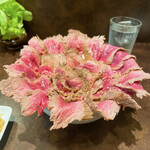
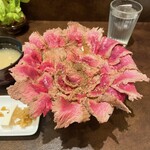
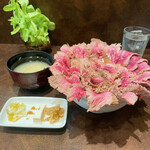
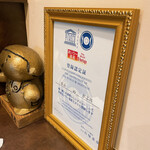
starrow10
3.50
Menu: Gobudon
Price: 1,600 yen
I had been wanting to go for a while, but I finally made it. The location is a bit hard to find. Not knowing the portion size, I played it safe and ordered a regular-sized Gobudon (Roast Beef Bowl). The presentation makes it look like a lot, but it's actually a normal bowl size. Under the roast beef, there is a bed of cabbage. The seasoning is relatively simple, mainly salt and pepper. It's more about enjoying the taste of the ingredients. I chose the signature menu this time, but I would like to try other Western dishes if I have the chance.
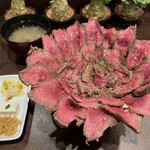
osakenomitai_88
3.50
We visited this famous restaurant known for its Gabu-don with four people. The counter was lined with cabbage, which we initially mistook for wasabi haha. We ordered the Gabu-don 180g and the cheese hamburger. We cut the cheese hamburger into four pieces and it was invincible! Next time, I want to order the hamburger as a set meal. The Gabu-don surprisingly had the perfect amount and we finished it in no time. We warmed up with miso soup before heading home. The dishes looked fancy and delicious, and they tasted consistently delicious as well.

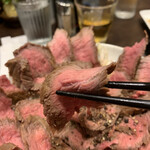
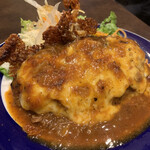
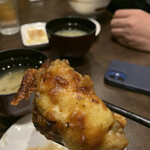
tackeycake
3.50
Gyudon is a restaurant I've always wanted to visit since seeing it on TV. My wish came true! The artistic presentation of the meat was truly impressive. Each slice of meat was delicious, bursting with flavor with every bite. For meat lovers, this bowl was a delight. Thank you for the wonderful meal.
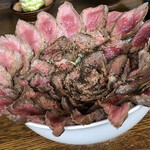
トントンマン
3.60
In my hometown of Musashikoyama, there is a historic and bustling shopping street called Palm Shotengai. However, overshadowed by this is a small group of shopping streets on the west side of the station, including Nishiguchi Shotengai, Jusankai, Hakko-kai, and the Heiwa-dori Shotengai a bit further away from the station. Among these, Nishiguchi Shotengai is a familiar place for me as it is on the way to the station from my home, and reminiscing about the changes in the shops there really brings out the sense of history. In the past, the largest shop in the center of Nishiguchi Shotengai was a store called Morihara Electric. Back in the day, there were many such electronics stores scattered throughout the town, especially during my student days, but they have gradually been phased out due to the rise of large-scale electronics retailers and changes in distribution networks by electronics manufacturers. The site of Morihara now houses a recycling shop, which is a clear reflection of the changing times. Many long-established restaurants have also closed down due to generational shifts, and the closures of soba restaurant "Tamaya" and izakaya "Hinode" in recent years were particularly poignant as they had made a mark in the dining scene. However, the opening of new types of eateries at these closed-down locations can be seen as a welcome sign of renewal. The restaurant I visited for lunch that day used to operate in Meguro-Honcho 3-chome along Route 26 (formerly Gabu). Nearby, there is also the well-known Chinese restaurant "Ginga", but it is located outside the shopping street and does not benefit from as much foot traffic. Therefore, the decision to relocate to this spot in Nishiguchi Shotengai, which sees much more pedestrian traffic, makes sense. The previous occupant of this location was an izakaya called "Sakura". It was not a very old establishment, and I remember a time when they also served lunch, including tonkatsu. However, due to the uncertainties brought about by the COVID-19 pandemic, or perhaps as part of infection prevention measures, there were renovation works going on, and ultimately the izakaya closed down, making way for the current restaurant. The new restaurant has been actively offering lunch since its previous location, and it opens from 11:30 am. On this day, I arrived at around 11:40 am and found myself to be the first customer. The interior of the restaurant consists of 5 counter seats and 4 two-person table seats, totaling 13 seats. While it is still quite cozy, it is much more spacious compared to the cramped feeling of the previous establishment, and the recent renovations have given it a clean and fresh look. I chose to sit at the end of the counter. The lunch menu displayed inside the restaurant is the same as the one outside, featuring 9 items. Among them, the signature dish is the "Gabu-don", with 180g priced at 1,600 yen, 270g at 2,300 yen, and 1 pound (453g) at 3,850 yen. The prices are generally proportional to the portion size. Other menu items are mainly Western dishes, with the cheapest being Spaghetti Gratin at 1,000 yen, followed by Hamburg Steak at 1,100 yen, Omelette Rice, Beef Curry, and Miso Pork at 1,200 yen each. Considering the lunch prices in the area, the prices are somewhat on the higher side. I ordered the standard Gabu-don with 180g for 1,600 yen. The Gabu-don arrived in about 8 minutes, accompanied by a side dish and miso soup. The Gabu-don consists of rice topped with shredded cabbage and beautifully arranged roast beef petals. Each slice of roast beef has a gradient from a deep red center to the outer edges, making it look very luxurious. It is a moment of luxury to delicately pick apart and savor each slice with chopsticks.
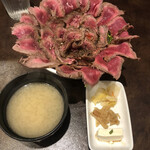


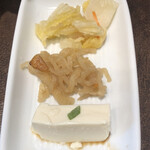
☆まっちゃん
3.90
On March 4, 2023, I visited the restaurant with two friends for the first time since it moved. We stopped by the famous bargain sale at Hakusui-sha near the neighborhood, and decided to have lunch as our first meal at the new location. The specialty dish, "Gubu-don," is well-known and featured in the media's Musashi-Koyama special. Gubu-don is a visual dish made of thinly sliced beef steak arranged like flower petals, and is a favorite among regular customers. The restaurant used to be located along Route 26, but last December, it relocated to the area next to Nippon Ryori Sakura, a Japanese restaurant in the Nishi-guchi shopping street near the Musashikoyama-dai High School. I had visited the previous location 12 years ago, where the husband and wife duo ran the place, with the husband handling the cooking. The menu includes items such as Gubu-don (180g/1600 yen), Gubu-don 1.5 (270g/2300 yen), Gubu-don 1 pound (453g/3850 yen), Pork Stamina Yaki (1200 yen), Hamburger Steak (1100 yen), and Omurice (1200 yen). While Gubu-don is the most famous dish, the menu reveals that it is a proper Western-style restaurant. When I ordered red wine, the wife brought out a small plate with pickled cabbage, dried radish, and tofu, saying, "I'm not sure if it will match well." The dish I ordered was the "Gubu-don 1.5" (2300 yen) - my first Gubu-don in 12 years. The beef steak is thinly sliced and arranged like flower petals, creating a visually appealing dish. Although similar plating can be found in other restaurants now, this place is likely the originator of the style. The meat is seasoned only with salt and pepper, served on a bed of shredded cabbage, and flavored rice soaked in a sweet and savory sauce underneath. The portion size is moderate, so if you're really hungry, there's also the Gubu-don 1 pound option (453g). The taste of the meat, while lacking the rich flavor of Japanese beef due to being lean meat, pairs well with the sweet sauce and rice. The miso soup, with tofu in it, is delicious with a gentle dashi flavor. My friend ordered the "Homemade Pork Miso-marinated Grilled" (1200 yen), and I had a taste - it was incredibly delicious and went well with the rice. We also had a bottle of red wine (half bottle for 1800 yen) - Santa Helena Reserva Siglo de Oro Cabernet Sauvignon (Chilean), with a berry-like flavor that was easy to drink and paired perfectly with the Gubu-don. All prices mentioned are tax included. [Amazing Points] It's not just about the Gubu-don, this is a genuine Western-style restaurant. [Improvements] None in particular. Having enjoyed the Gubu-don after a long time, it remains a timeless specialty of Musashi-Koyama. I hope it continues to be a staple for a long time. I look forward to trying other items on the menu on my next visit. Thank you for the meal.
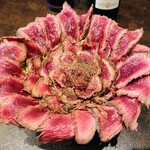
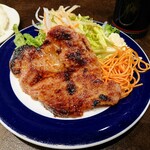
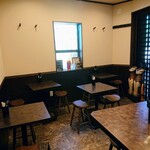
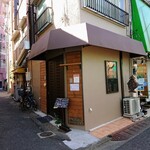
E☆mama
4.00
Visited Gabu for the first time after their relocation. Ordered the Gabu Don with 180g of roast beef, topped with a sweet sauce. The meat was tender and delicious, cooked rare to perfection. It was beautifully presented like a rose, with a generous amount of pepper on the center. Underneath the roast beef, there was cabbage which paired well with the sweet sauce. The meal came with miso soup and side dishes (tofu, dried daikon, pickles). The portion size was generous for a regular serving. Payment is cash only. Overall, it was a satisfying meal. Thank you for the delicious food! #MusashikoyamaGourmet #MusashikoyamaLunch #MusashikoyamaMeatDishes #Gabu #GabuDining #FoodieGabu #RoastBeef #RoastBeefDon #MeatLover #Donburi #RoseDon #Musashikoyama #Musako
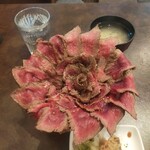
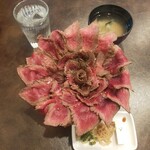
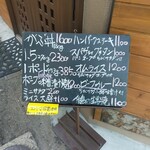
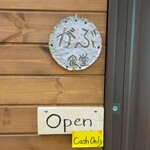
happy_meal_tokyo
4.10
I couldn't find out where the restaurant had moved to from its previous location, but I happened to come across it while passing by. It had transformed into a clean and tidy little shop. The specialty of the place used to be the beef bowl, which was essentially a roast beef bowl. The presentation alone is impressive. The pepper seasoning is just right and delicious. Underneath the roast beef, there is a bed of cabbage which is comforting. It seemed even more delicious than before, perhaps because it had been a while since I last had it. The miso soup, side dish, and pickles were also well-prepared without cutting any corners. I look forward to trying out other menu items next time.

BOBchan
3.30
When you open the door on the first floor of a detached house, you are greeted with a cheerful, energetic voice. I ordered the roast beef bowl. You can increase the amount of meat for an additional fee. The specialty seems to be this, but there are also other set meal menus. Salad is an additional 200 yen. Miso soup and pickles come with the bowl from the start. I was surprised by the amount of meat when it arrived. The rice ran out before the meat. The portion was so large that I got a little tired of it halfway through, but I think men would be happy with this bowl (some even added extra meat). It's a cozy little shop. It seems like a place where people living nearby might drop by. Thank you for the meal.
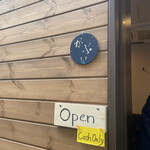

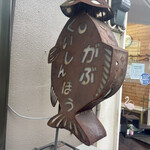
もしやもじゃ。
3.80
The restaurant not only serves delicious Gyu-don, but also has tasty Western dishes. I tried something other than Gyu-don for lunch and it turned out to be a great choice. The Spaghetti Gratin was creamy and allowed me to savor the bacon and onions. The Hamburg Steak was surprisingly tender and I would definitely order it next time. The Omu-rice was also delicious with ketchup evenly spread throughout.
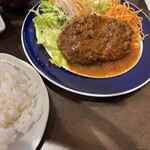
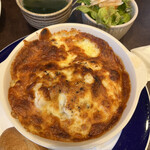
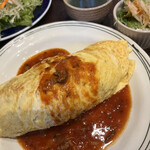
buff-buff
3.70
When it was located along Route 26 in Musashi-Koyama, I visited "Gabu" several times to eat their famous "Gabu Donburi". Now, "Gabu" has moved to a shopping street near Koyama-dai High School and reopened as a new store. The place used to be an izakaya, but it has been renovated into a beautiful restaurant. When I was seated at the counter and looked at the menu, I saw options like: - Gabu Donburi 180g for 1600 yen - Meat 1.5 270g for 2300 yen - Meat 1 pound 453g for 3850 yen There are also other dishes like Hamburger Steak for 1100 yen, Spaghetti Gratin for 1000 yen, and Pork Miso-marinated Grilled for 1200 yen. Prices have increased somewhat compared to five years ago. The Meat 1.5 for 2300 yen is a bit pricey for lunch, but if you want to eat a lot of meat, this is the dish to go for. As soon as the order is taken, you can hear the sound of the owner cooking the meat in a frying pan. Perhaps they pre-cook the roast beef to a certain extent using low-temperature cooking, and then finish it off by giving it a nice sear. The owner then carefully slices the meat one piece at a time. The owner's wife then skillfully arranges the meat on a bowl disguised as rice to complete the dish. The Gabu Donburi still looks impressive as ever - like a big flower of meat. The curves of the meat overflowing from the bowl are also pleasing to the eye. When I tried the meat, the rare roast beef was thinly sliced and very tender. It used to be thicker and a bit tough to chew, but now it's easier to eat with the thin slices and tender texture. The sweet soy sauce dressing on top is also elegant. Under the meat, a little cabbage is laid out, and the rice is fluffy and delicious, but the portion is still small. Despite the generous amount of meat, the rice is lacking, creating an unusual dilemma of having too little rice. The 270g of meat provided a satisfying amount and deliciousness. However, I would prefer to have a larger portion of rice.
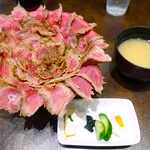

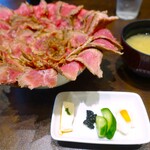
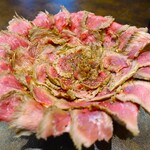
ふさぎんぽ3世
3.60
I saw it on Instagram and was drawn in by the visuals, so I decided to go! I thought there might be a long line, but I was able to get in easily. I ordered the "bu-don" and it was truly impressive in appearance! The portion size was quite generous and the taste was satisfying! If I'm in the area again, I will definitely go back!
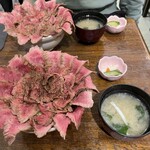
nao.20180304
3.50
Munch on the famous roast beef bowl at a restaurant in Musashi-Koyama for lunch! The "Gyudon" (1 pound of meat) costs 3500 yen and comes with a generous 453g portion of meat overflowing from the bowl. The meat is slightly firm and very satisfying to eat. The clean red color of the meat is appetizing, and the black pepper seasoning adds a nice touch. The rice is soaked in a sweet and savory sauce, making it delicious. The "Gyudon" comes in three sizes, and this time I chose the largest one, but the amount of rice is the same for all sizes! By the way, this time I shared it with a friend, but if you're a man, you might be able to finish it on your own! Additionally, we also ordered a mini salad for 200 yen.

ebiplitz
4.50
The famous restaurant from Musashi-Koyama has moved near the station. I tried their specialty dish, the roast beef bowl. The taste and atmosphere remain the same, and the cost performance is excellent.
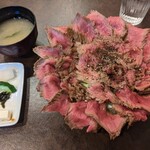
もしやもじゃ。
3.70
The restaurant "Gabudon" is still going strong even after relocating! The new place is clean and has a nice atmosphere. I want to try other menu items next time!
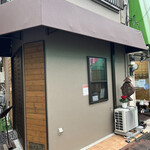
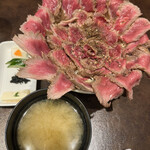
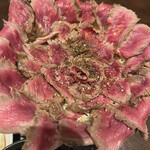
Email Login